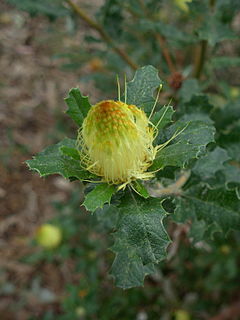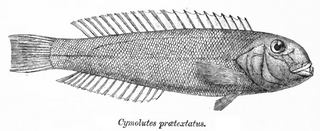
Stipa is a genus of around 300 large perennial hermaphroditic grasses collectively known as feather grass, needle grass, and spear grass. They are placed in the subfamily Pooideae and the tribe Stipeae, which also contains many species formerly assigned to Stipa, which have since been reclassified into new genera.
Pearly or pearlie may refer to:

Banksia undata, commonly known as urchin dryandra, is a species of shrub that is endemic to the southwest of Western Australia. It has sessile, wedge-shaped, wavy, serrated leaves, pale yellow flowers in heads of between 80 and 160, and later up to eight follicles in each head.

The splendid fairywren is a passerine bird in the Australasian wren family, Maluridae. It is also known simply as the splendid wren or more colloquially in Western Australia as the blue wren. The splendid fairywren is found across much of the Australian continent from central-western New South Wales and southwestern Queensland over to coastal Western Australia. It inhabits predominantly arid and semi-arid regions. Exhibiting a high degree of sexual dimorphism, the male in breeding plumage is a small, long-tailed bird of predominantly bright blue and black colouration. Non-breeding males, females and juveniles are predominantly grey-brown in colour; this gave the early impression that males were polygamous as all dull-coloured birds were taken for females. It comprises several similar all-blue and black subspecies that were originally considered separate species.

Aeoliscus strigatus, also known as the razorfish, jointed razorfish or coral shrimpfish, is a member of the family Centriscidae of the order Syngnathiformes. This unique fish adopts a head-down tail-up position as an adaptation for hiding among sea urchin spines. The razorfish is found in coastal waters in the Indo-West Pacific. Its natural habitat includes beds of sea grass and coral reefs, where sea urchins are found.

The northeast African mole-rat is a species of rodent in the family Spalacidae and is found in Ethiopia, Somalia, and northwest Kenya. Its natural habitats are subtropical or tropical moist montane forests, dry savanna, high-altitude shrubland and grassland. It lives a solitary existence underground and produces a small litter of pups twice a year, in the two rainy seasons. Some taxonomic authorities lump this species, along with a number of others in the genus, in which case the English name East African mole-rat is used.

Charpentieria is a genus of small, very elongate, air-breathing land snails, terrestrial pulmonate gastropod mollusks in the family Clausiliidae, the door snails, all of which have a clausilium.

Macromia is a genus of large dragonflies in the family Macromiidae. They are commonly known as river cruisers from their habit of cruising long distances along river banks. Most species of Macromia occur in the tropical Australasian region, with one species being found in Europe , and a few species occurring in North America.

Fouquieria is a genus of 11 species of desert plants, the sole genus in the family Fouquieriaceae. The genus includes the ocotillo and the Boojum tree or cirio. They have semisucculent stems with thinner spikes projecting from them, with leaves on the bases spikes. They are unrelated to cacti and do not look much like them; their stems are proportionately thinner than cactus stems and their leaves are larger.

Betta, is a large genus of small, active, often colorful, freshwater ray-finned fishes, known as "bettas", in the gourami family (Osphronemidae). The best known Betta species is B. splendens, commonly known as the Siamese fighting fish.
The Java razorfish is a doubtful species of wrasse about which little is known. This fish gets the name "javanicus" from Java, Indonesia, from which the type specimen was supposedly obtained. Also, some fish have been reported to have been spotted in the Red Sea. The validity of this species is questioned pending further studies.
Pseudogaurotina is a genus of beetles in the family Cerambycidae, containing the following species:

The pearly razorfish or cleaver wrasse, Xyrichtys novacula, is a species of wrasse. It is of minor importance to local commercial fisheries and is popular as a game fish. It can also be found in the aquarium trade.

Cymolutes is a genus of wrasses native to the Indian and Pacific Oceans.
Iniistius is a genus of wrasses native to the Indian and Pacific Oceans.
The Macropodusinae are a subfamily of freshwater anabantiform fishes in the gourami family Osphronemidae, which includes the paradisefish, fighting fish and licorice gouramis. Like all members of the family, these are air breathing fishes that frequently inhabit oxygen poor environments hostile to other fishes. They are native to Asia, from Pakistan and India to the Malay Archipelago and north-easterly towards Korea. Many members are common aquarium fish; by far the most famous is the Siamese fighting fish, Betta splendens. Most of the 70+ betta species are paternal mouthbrooders; the remaining members of the subfamily are bubblenesters like most osphronemids.

Iniistius pavo, the peacock wrasse or blue razorfish, is a species of marine ray-finned fish from the family Labridae, the wrasses, which has a wide Indo-Pacific distribution.
Macrocoma is a genus of leaf beetles in the subfamily Eumolpinae. It contains about 100 species, which are found in tropical Africa, around the Mediterranean, on the Canary Islands, in western and central Asia, and in India.

Novaculops pastellus, the Lord Howe sandy, is a fish of the family Labridae, subfamily Xyrichtyinae, commonly known as razorfishes. It's a rare fish known only from the Lord Howe Island region in the Tasman Sea, and inhabits open sandy bottoms. Like other razorfishes, it dives quickly into the sand when threatened. This species was originally described in the genus Xyrichthys and later transferred to Novaculops. It is listed as Least Concern in the IUCN Red List.
















